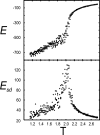Characterization of protein-folding pathways by reduced-space modeling
- PMID: 17636132
- PMCID: PMC1941469
- DOI: 10.1073/pnas.0702265104
Characterization of protein-folding pathways by reduced-space modeling
Abstract
Ab initio simulations of the folding pathways are currently limited to very small proteins. For larger proteins, some approximations or simplifications in protein models need to be introduced. Protein folding and unfolding are among the basic processes in the cell and are very difficult to characterize in detail by experiment or simulation. Chymotrypsin inhibitor 2 (CI2) and barnase are probably the best characterized experimentally in this respect. For these model systems, initial folding stages were simulated by using CA-CB-side chain (CABS), a reduced-space protein-modeling tool. CABS employs knowledge-based potentials that proved to be very successful in protein structure prediction. With the use of isothermal Monte Carlo (MC) dynamics, initiation sites with a residual structure and weak tertiary interactions were identified. Such structures are essential for the initiation of the folding process through a sequential reduction of the protein conformational space, overcoming the Levinthal paradox in this manner. Furthermore, nucleation sites that initiate a tertiary interactions network were located. The MC simulations correspond perfectly to the results of experimental and theoretical research and bring insights into CI2 folding mechanism: unambiguous sequence of folding events was reported as well as cooperative substructures compatible with those obtained in recent molecular dynamics unfolding studies. The correspondence between the simulation and experiment shows that knowledge-based potentials are not only useful in protein structure predictions but are also capable of reproducing the folding pathways. Thus, the results of this work significantly extend the applicability range of reduced models in the theoretical study of proteins.
Conflict of interest statement
The authors declare no conflict of interest.
Figures




Similar articles
-
Protein modeling with reduced representation: statistical potentials and protein folding mechanism.Acta Biochim Pol. 2005;52(4):741-8. Epub 2005 May 31. Acta Biochim Pol. 2005. PMID: 15933762 Review.
-
Monte Carlo simulations of protein folding. I. Lattice model and interaction scheme.Proteins. 1994 Apr;18(4):338-52. doi: 10.1002/prot.340180405. Proteins. 1994. PMID: 8208726
-
Protein conformational transitions coupled to binding in molecular recognition of unstructured proteins: deciphering the effect of intermolecular interactions on computational structure prediction of the p27Kip1 protein bound to the cyclin A-cyclin-dependent kinase 2 complex.Proteins. 2005 Feb 15;58(3):706-16. doi: 10.1002/prot.20351. Proteins. 2005. PMID: 15609350
-
Folding with downhill behavior and low cooperativity of proteins.Proteins. 2006 Apr 1;63(1):165-73. doi: 10.1002/prot.20857. Proteins. 2006. PMID: 16416404
-
Inter-residue interactions in protein folding and stability.Prog Biophys Mol Biol. 2004 Oct;86(2):235-77. doi: 10.1016/j.pbiomolbio.2003.09.003. Prog Biophys Mol Biol. 2004. PMID: 15288760 Review.
Cited by
-
Coarse-grained force field: general folding theory.Phys Chem Chem Phys. 2011 Oct 14;13(38):16890-901. doi: 10.1039/c1cp20752k. Epub 2011 Jun 3. Phys Chem Chem Phys. 2011. PMID: 21643583 Free PMC article. Review.
-
A free-energy approach for all-atom protein simulation.Biophys J. 2009 May 6;96(9):3483-94. doi: 10.1016/j.bpj.2008.12.3921. Biophys J. 2009. PMID: 19413955 Free PMC article.
-
CABS-dock web server for the flexible docking of peptides to proteins without prior knowledge of the binding site.Nucleic Acids Res. 2015 Jul 1;43(W1):W419-24. doi: 10.1093/nar/gkv456. Epub 2015 May 5. Nucleic Acids Res. 2015. PMID: 25943545 Free PMC article.
-
Exploring protein functions from structural flexibility using CABS-flex modeling.Protein Sci. 2024 Sep;33(9):e5090. doi: 10.1002/pro.5090. Protein Sci. 2024. PMID: 39194135 Free PMC article. Review.
-
Protein-peptide molecular docking with large-scale conformational changes: the p53-MDM2 interaction.Sci Rep. 2016 Dec 1;6:37532. doi: 10.1038/srep37532. Sci Rep. 2016. PMID: 27905468 Free PMC article.
References
-
- Matouschek A, Serrano L, Fersht AR. J Mol Biol. 1992;224:819–835. - PubMed
-
- Bycroft M, Matouschek A, Kellis JT, Jr, Serrano L, Fersht AR. Nature. 1990;346:488–490. - PubMed
-
- Udgaonkar JB, Baldwin RL. Nature. 1988;335:694–699. - PubMed
-
- Serrano L, Matouschek A, Fersht AR. J Mol Biol. 1992;224:805–818. - PubMed
MeSH terms
Substances
LinkOut - more resources
Full Text Sources

